Analyzing Short-Term Investment Predictions with Valuation Techniques
VerifiedAdded on 2020/07/23
|35
|8776
|124
Report
AI Summary
This report investigates the effectiveness of valuation techniques in predicting investment returns within a short-term horizon. It explores the application of various financial tools, including the Discounted Cash Flow (DCF) model and bond valuation techniques, to assess their suitability for short-term investments. The study utilizes a deductive approach and positivism philosophy, analyzing secondary data from five companies (IHG, AZN, BAE System, Associated British Food, and Admiral Group) to evaluate the predictive power of valuation ratios such as P/E and dividend payout ratios. The analysis compares the intrinsic values of companies under both short and long-term horizons, aiming to determine whether these techniques offer reliable signals for short-term investment decisions. The report also examines the limitations of these techniques and suggests ways to enhance short-term predictability, providing valuable insights for investors and scholars interested in financial analysis and investment strategies. The findings suggest that the DCF model is highly effective, presenting a fair view in both short and long investment horizons.
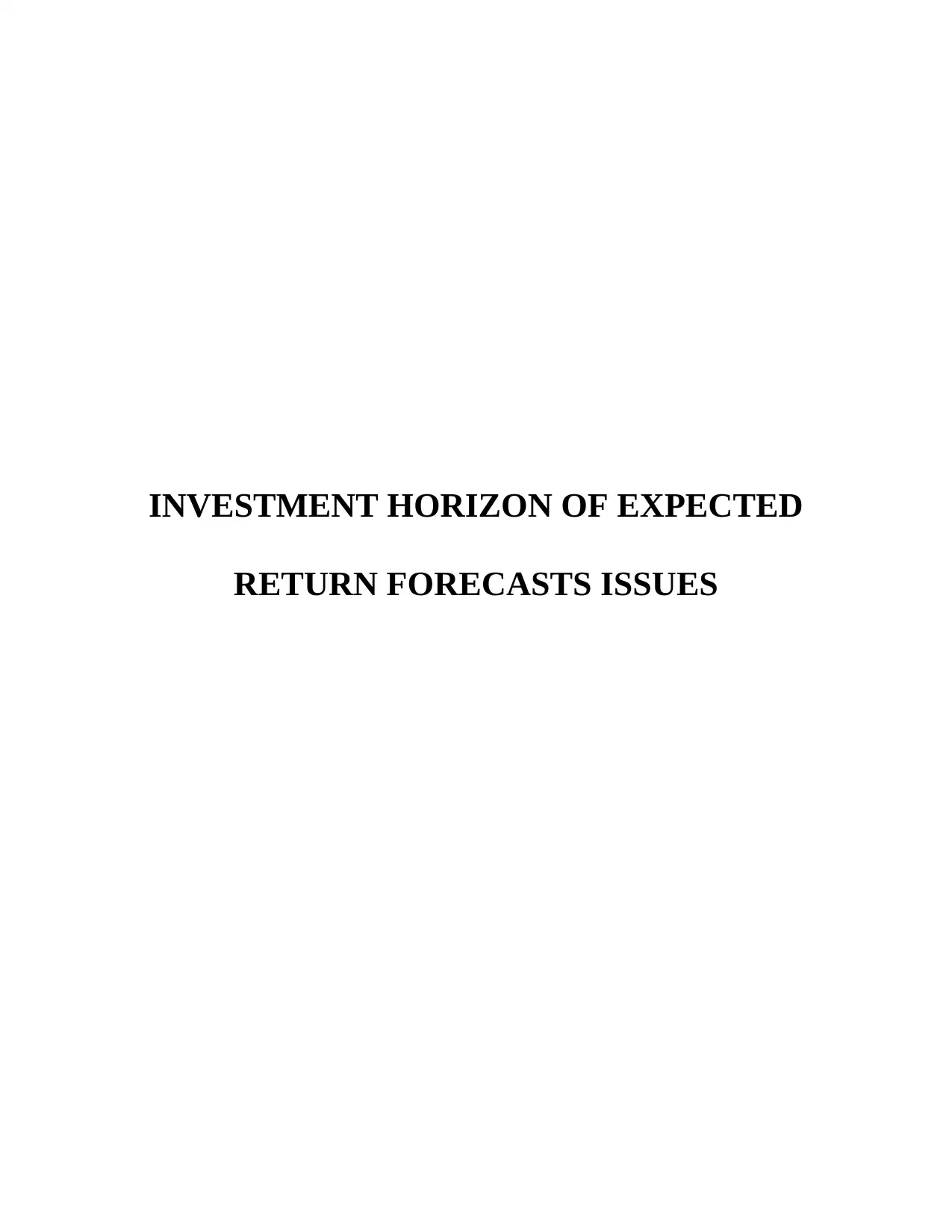
INVESTMENT HORIZON OF EXPECTED
RETURN FORECASTS ISSUES
RETURN FORECASTS ISSUES
Paraphrase This Document
Need a fresh take? Get an instant paraphrase of this document with our AI Paraphraser

ACKNOWLEDGEMENT
I am thankful to my tutor, friends and relatives who gave me guidance and support for
this project. In completing my dissertation on the suitability of equity and bond valuation
pertaining to short and long run they always encouraged me to do it in the best possible way. In
addition to this, I also appreciate my mentor for giving me guidance in preparing dissertation.
From his support and experience I was in the position to complete dissertation in a right manner.
I am thankful to my tutor, friends and relatives who gave me guidance and support for
this project. In completing my dissertation on the suitability of equity and bond valuation
pertaining to short and long run they always encouraged me to do it in the best possible way. In
addition to this, I also appreciate my mentor for giving me guidance in preparing dissertation.
From his support and experience I was in the position to complete dissertation in a right manner.
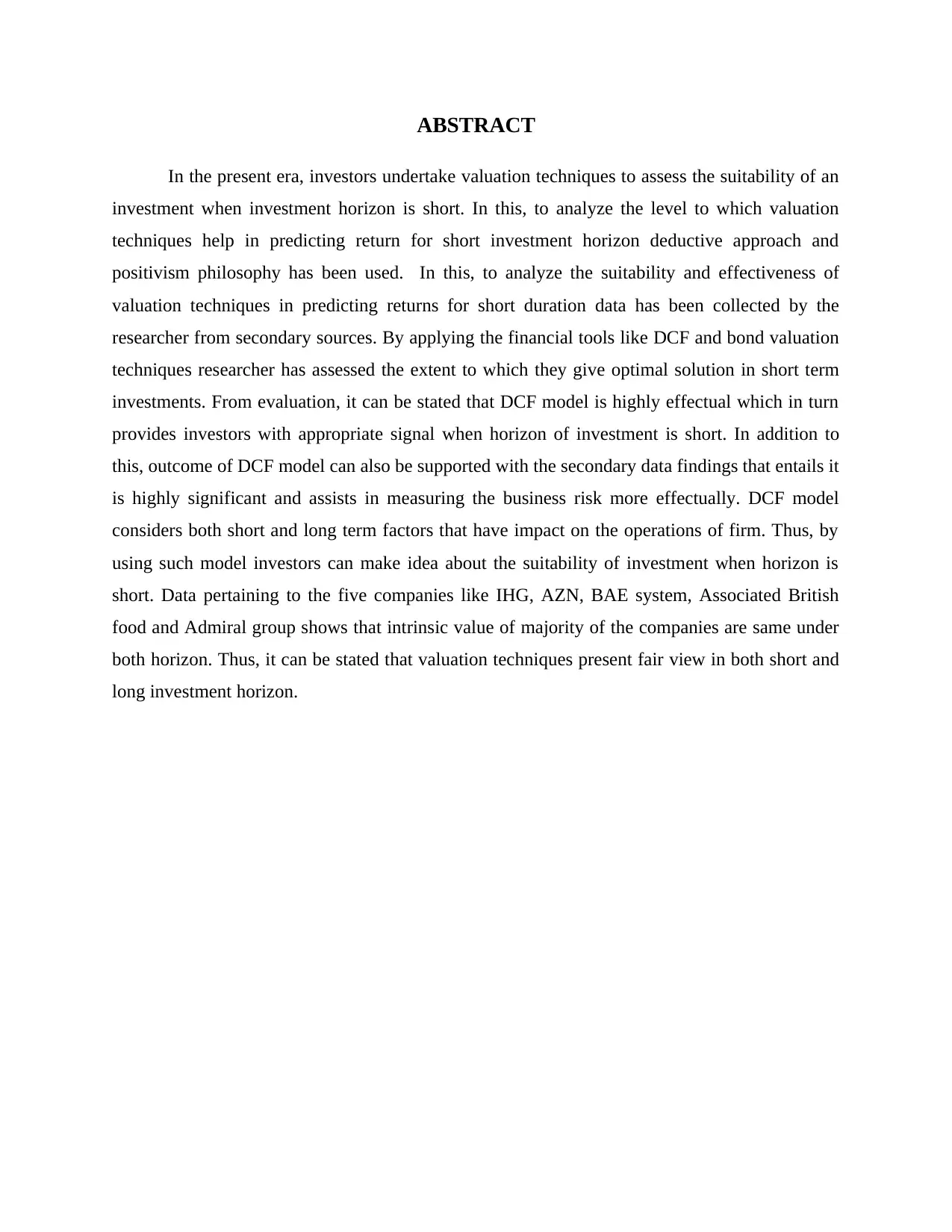
ABSTRACT
In the present era, investors undertake valuation techniques to assess the suitability of an
investment when investment horizon is short. In this, to analyze the level to which valuation
techniques help in predicting return for short investment horizon deductive approach and
positivism philosophy has been used. In this, to analyze the suitability and effectiveness of
valuation techniques in predicting returns for short duration data has been collected by the
researcher from secondary sources. By applying the financial tools like DCF and bond valuation
techniques researcher has assessed the extent to which they give optimal solution in short term
investments. From evaluation, it can be stated that DCF model is highly effectual which in turn
provides investors with appropriate signal when horizon of investment is short. In addition to
this, outcome of DCF model can also be supported with the secondary data findings that entails it
is highly significant and assists in measuring the business risk more effectually. DCF model
considers both short and long term factors that have impact on the operations of firm. Thus, by
using such model investors can make idea about the suitability of investment when horizon is
short. Data pertaining to the five companies like IHG, AZN, BAE system, Associated British
food and Admiral group shows that intrinsic value of majority of the companies are same under
both horizon. Thus, it can be stated that valuation techniques present fair view in both short and
long investment horizon.
In the present era, investors undertake valuation techniques to assess the suitability of an
investment when investment horizon is short. In this, to analyze the level to which valuation
techniques help in predicting return for short investment horizon deductive approach and
positivism philosophy has been used. In this, to analyze the suitability and effectiveness of
valuation techniques in predicting returns for short duration data has been collected by the
researcher from secondary sources. By applying the financial tools like DCF and bond valuation
techniques researcher has assessed the extent to which they give optimal solution in short term
investments. From evaluation, it can be stated that DCF model is highly effectual which in turn
provides investors with appropriate signal when horizon of investment is short. In addition to
this, outcome of DCF model can also be supported with the secondary data findings that entails it
is highly significant and assists in measuring the business risk more effectually. DCF model
considers both short and long term factors that have impact on the operations of firm. Thus, by
using such model investors can make idea about the suitability of investment when horizon is
short. Data pertaining to the five companies like IHG, AZN, BAE system, Associated British
food and Admiral group shows that intrinsic value of majority of the companies are same under
both horizon. Thus, it can be stated that valuation techniques present fair view in both short and
long investment horizon.
⊘ This is a preview!⊘
Do you want full access?
Subscribe today to unlock all pages.

Trusted by 1+ million students worldwide
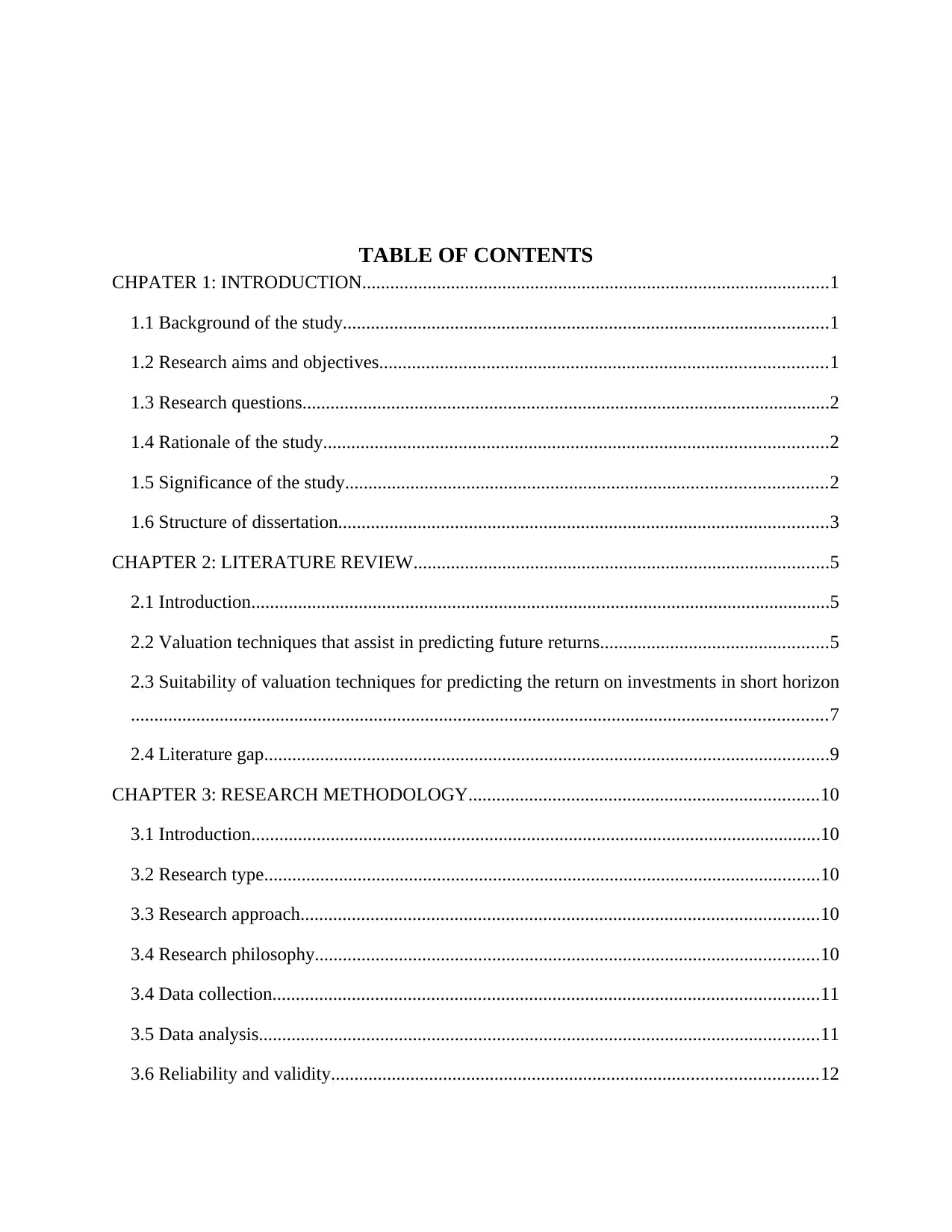
TABLE OF CONTENTS
CHPATER 1: INTRODUCTION....................................................................................................1
1.1 Background of the study........................................................................................................1
1.2 Research aims and objectives................................................................................................1
1.3 Research questions.................................................................................................................2
1.4 Rationale of the study............................................................................................................2
1.5 Significance of the study.......................................................................................................2
1.6 Structure of dissertation.........................................................................................................3
CHAPTER 2: LITERATURE REVIEW.........................................................................................5
2.1 Introduction............................................................................................................................5
2.2 Valuation techniques that assist in predicting future returns.................................................5
2.3 Suitability of valuation techniques for predicting the return on investments in short horizon
.....................................................................................................................................................7
2.4 Literature gap.........................................................................................................................9
CHAPTER 3: RESEARCH METHODOLOGY...........................................................................10
3.1 Introduction..........................................................................................................................10
3.2 Research type.......................................................................................................................10
3.3 Research approach...............................................................................................................10
3.4 Research philosophy............................................................................................................10
3.4 Data collection.....................................................................................................................11
3.5 Data analysis........................................................................................................................11
3.6 Reliability and validity........................................................................................................12
CHPATER 1: INTRODUCTION....................................................................................................1
1.1 Background of the study........................................................................................................1
1.2 Research aims and objectives................................................................................................1
1.3 Research questions.................................................................................................................2
1.4 Rationale of the study............................................................................................................2
1.5 Significance of the study.......................................................................................................2
1.6 Structure of dissertation.........................................................................................................3
CHAPTER 2: LITERATURE REVIEW.........................................................................................5
2.1 Introduction............................................................................................................................5
2.2 Valuation techniques that assist in predicting future returns.................................................5
2.3 Suitability of valuation techniques for predicting the return on investments in short horizon
.....................................................................................................................................................7
2.4 Literature gap.........................................................................................................................9
CHAPTER 3: RESEARCH METHODOLOGY...........................................................................10
3.1 Introduction..........................................................................................................................10
3.2 Research type.......................................................................................................................10
3.3 Research approach...............................................................................................................10
3.4 Research philosophy............................................................................................................10
3.4 Data collection.....................................................................................................................11
3.5 Data analysis........................................................................................................................11
3.6 Reliability and validity........................................................................................................12
Paraphrase This Document
Need a fresh take? Get an instant paraphrase of this document with our AI Paraphraser
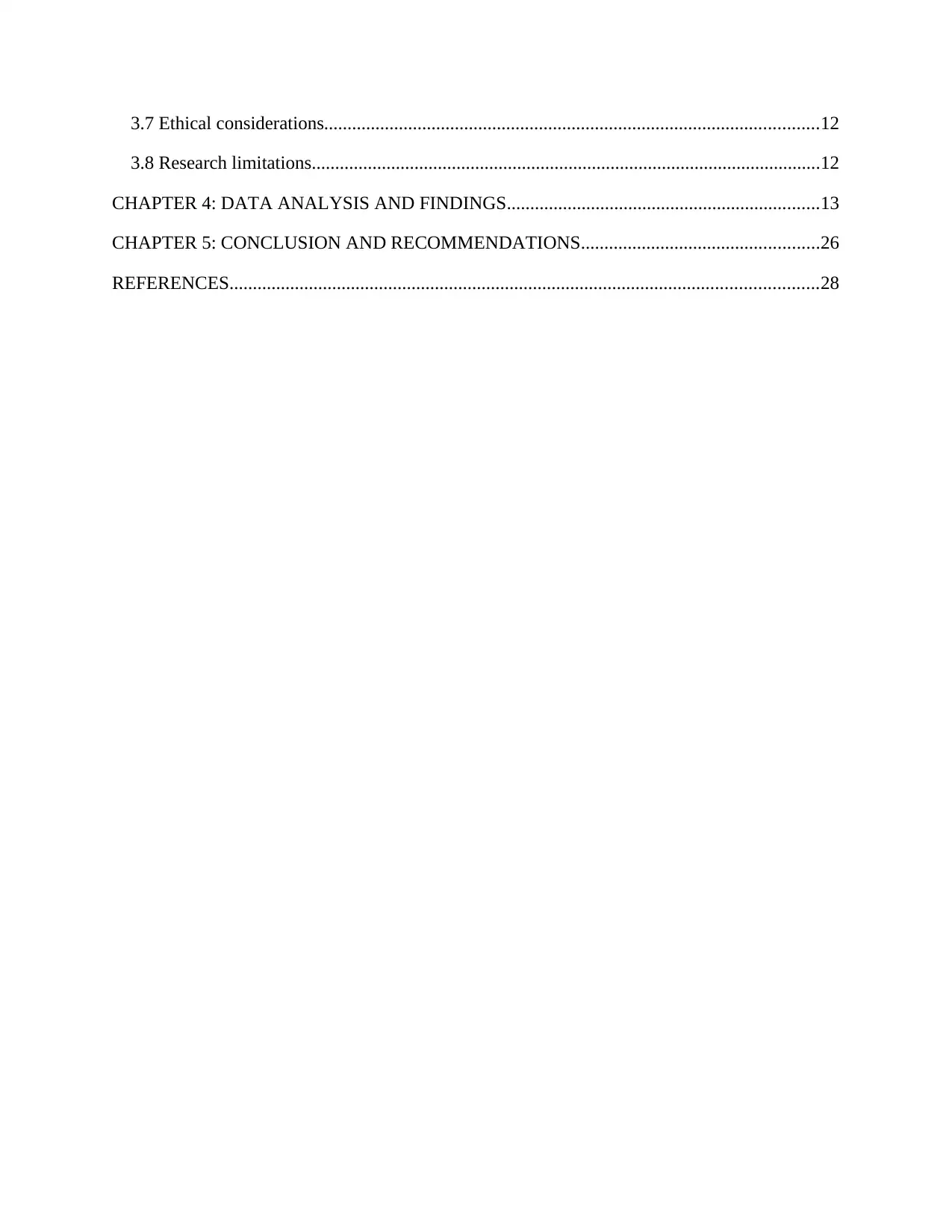
3.7 Ethical considerations..........................................................................................................12
3.8 Research limitations.............................................................................................................12
CHAPTER 4: DATA ANALYSIS AND FINDINGS...................................................................13
CHAPTER 5: CONCLUSION AND RECOMMENDATIONS...................................................26
REFERENCES..............................................................................................................................28
3.8 Research limitations.............................................................................................................12
CHAPTER 4: DATA ANALYSIS AND FINDINGS...................................................................13
CHAPTER 5: CONCLUSION AND RECOMMENDATIONS...................................................26
REFERENCES..............................................................................................................................28
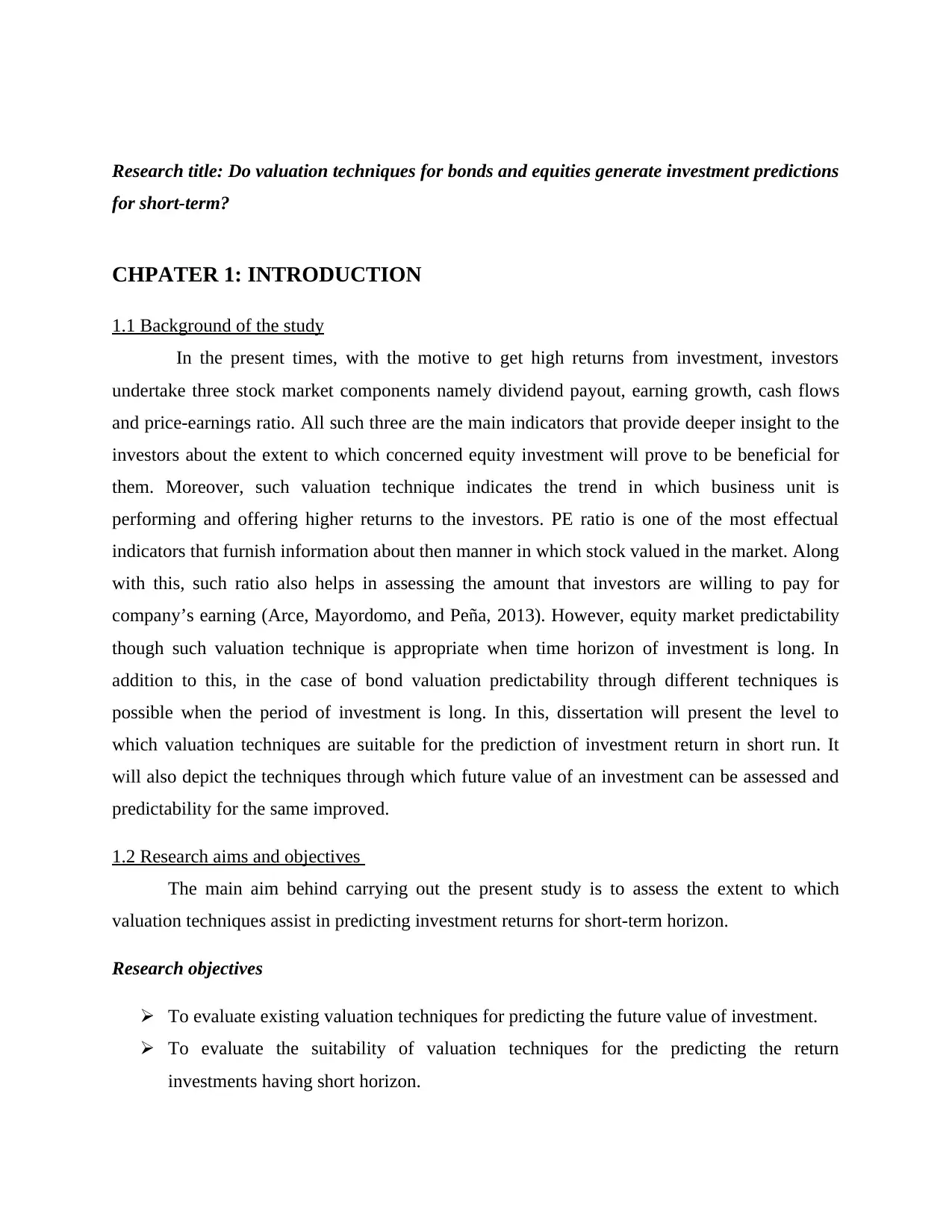
Research title: Do valuation techniques for bonds and equities generate investment predictions
for short-term?
CHPATER 1: INTRODUCTION
1.1 Background of the study
In the present times, with the motive to get high returns from investment, investors
undertake three stock market components namely dividend payout, earning growth, cash flows
and price-earnings ratio. All such three are the main indicators that provide deeper insight to the
investors about the extent to which concerned equity investment will prove to be beneficial for
them. Moreover, such valuation technique indicates the trend in which business unit is
performing and offering higher returns to the investors. PE ratio is one of the most effectual
indicators that furnish information about then manner in which stock valued in the market. Along
with this, such ratio also helps in assessing the amount that investors are willing to pay for
company’s earning (Arce, Mayordomo, and Peña, 2013). However, equity market predictability
though such valuation technique is appropriate when time horizon of investment is long. In
addition to this, in the case of bond valuation predictability through different techniques is
possible when the period of investment is long. In this, dissertation will present the level to
which valuation techniques are suitable for the prediction of investment return in short run. It
will also depict the techniques through which future value of an investment can be assessed and
predictability for the same improved.
1.2 Research aims and objectives
The main aim behind carrying out the present study is to assess the extent to which
valuation techniques assist in predicting investment returns for short-term horizon.
Research objectives
To evaluate existing valuation techniques for predicting the future value of investment.
To evaluate the suitability of valuation techniques for the predicting the return
investments having short horizon.
for short-term?
CHPATER 1: INTRODUCTION
1.1 Background of the study
In the present times, with the motive to get high returns from investment, investors
undertake three stock market components namely dividend payout, earning growth, cash flows
and price-earnings ratio. All such three are the main indicators that provide deeper insight to the
investors about the extent to which concerned equity investment will prove to be beneficial for
them. Moreover, such valuation technique indicates the trend in which business unit is
performing and offering higher returns to the investors. PE ratio is one of the most effectual
indicators that furnish information about then manner in which stock valued in the market. Along
with this, such ratio also helps in assessing the amount that investors are willing to pay for
company’s earning (Arce, Mayordomo, and Peña, 2013). However, equity market predictability
though such valuation technique is appropriate when time horizon of investment is long. In
addition to this, in the case of bond valuation predictability through different techniques is
possible when the period of investment is long. In this, dissertation will present the level to
which valuation techniques are suitable for the prediction of investment return in short run. It
will also depict the techniques through which future value of an investment can be assessed and
predictability for the same improved.
1.2 Research aims and objectives
The main aim behind carrying out the present study is to assess the extent to which
valuation techniques assist in predicting investment returns for short-term horizon.
Research objectives
To evaluate existing valuation techniques for predicting the future value of investment.
To evaluate the suitability of valuation techniques for the predicting the return
investments having short horizon.
⊘ This is a preview!⊘
Do you want full access?
Subscribe today to unlock all pages.

Trusted by 1+ million students worldwide
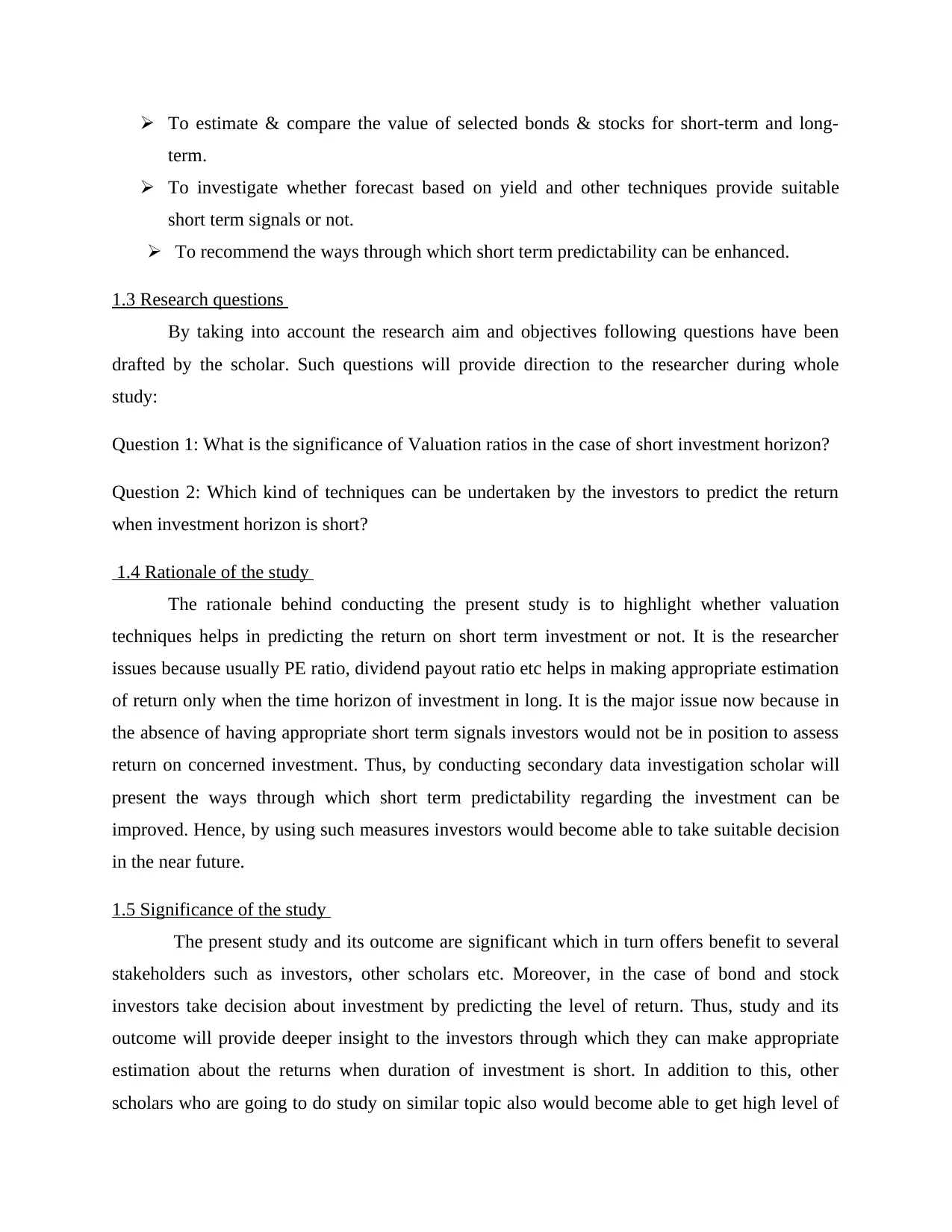
To estimate & compare the value of selected bonds & stocks for short-term and long-
term.
To investigate whether forecast based on yield and other techniques provide suitable
short term signals or not.
To recommend the ways through which short term predictability can be enhanced.
1.3 Research questions
By taking into account the research aim and objectives following questions have been
drafted by the scholar. Such questions will provide direction to the researcher during whole
study:
Question 1: What is the significance of Valuation ratios in the case of short investment horizon?
Question 2: Which kind of techniques can be undertaken by the investors to predict the return
when investment horizon is short?
1.4 Rationale of the study
The rationale behind conducting the present study is to highlight whether valuation
techniques helps in predicting the return on short term investment or not. It is the researcher
issues because usually PE ratio, dividend payout ratio etc helps in making appropriate estimation
of return only when the time horizon of investment in long. It is the major issue now because in
the absence of having appropriate short term signals investors would not be in position to assess
return on concerned investment. Thus, by conducting secondary data investigation scholar will
present the ways through which short term predictability regarding the investment can be
improved. Hence, by using such measures investors would become able to take suitable decision
in the near future.
1.5 Significance of the study
The present study and its outcome are significant which in turn offers benefit to several
stakeholders such as investors, other scholars etc. Moreover, in the case of bond and stock
investors take decision about investment by predicting the level of return. Thus, study and its
outcome will provide deeper insight to the investors through which they can make appropriate
estimation about the returns when duration of investment is short. In addition to this, other
scholars who are going to do study on similar topic also would become able to get high level of
term.
To investigate whether forecast based on yield and other techniques provide suitable
short term signals or not.
To recommend the ways through which short term predictability can be enhanced.
1.3 Research questions
By taking into account the research aim and objectives following questions have been
drafted by the scholar. Such questions will provide direction to the researcher during whole
study:
Question 1: What is the significance of Valuation ratios in the case of short investment horizon?
Question 2: Which kind of techniques can be undertaken by the investors to predict the return
when investment horizon is short?
1.4 Rationale of the study
The rationale behind conducting the present study is to highlight whether valuation
techniques helps in predicting the return on short term investment or not. It is the researcher
issues because usually PE ratio, dividend payout ratio etc helps in making appropriate estimation
of return only when the time horizon of investment in long. It is the major issue now because in
the absence of having appropriate short term signals investors would not be in position to assess
return on concerned investment. Thus, by conducting secondary data investigation scholar will
present the ways through which short term predictability regarding the investment can be
improved. Hence, by using such measures investors would become able to take suitable decision
in the near future.
1.5 Significance of the study
The present study and its outcome are significant which in turn offers benefit to several
stakeholders such as investors, other scholars etc. Moreover, in the case of bond and stock
investors take decision about investment by predicting the level of return. Thus, study and its
outcome will provide deeper insight to the investors through which they can make appropriate
estimation about the returns when duration of investment is short. In addition to this, other
scholars who are going to do study on similar topic also would become able to get high level of
Paraphrase This Document
Need a fresh take? Get an instant paraphrase of this document with our AI Paraphraser
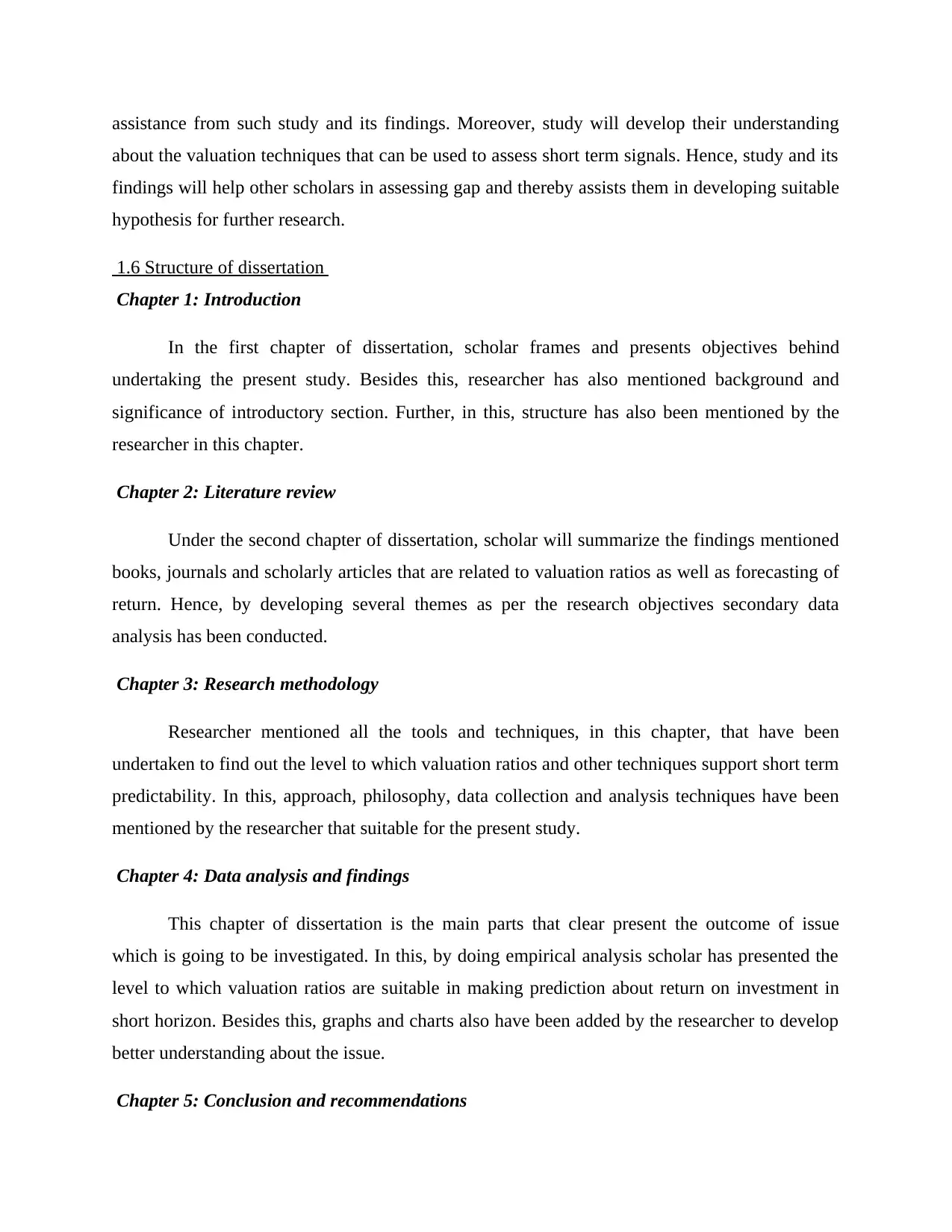
assistance from such study and its findings. Moreover, study will develop their understanding
about the valuation techniques that can be used to assess short term signals. Hence, study and its
findings will help other scholars in assessing gap and thereby assists them in developing suitable
hypothesis for further research.
1.6 Structure of dissertation
Chapter 1: Introduction
In the first chapter of dissertation, scholar frames and presents objectives behind
undertaking the present study. Besides this, researcher has also mentioned background and
significance of introductory section. Further, in this, structure has also been mentioned by the
researcher in this chapter.
Chapter 2: Literature review
Under the second chapter of dissertation, scholar will summarize the findings mentioned
books, journals and scholarly articles that are related to valuation ratios as well as forecasting of
return. Hence, by developing several themes as per the research objectives secondary data
analysis has been conducted.
Chapter 3: Research methodology
Researcher mentioned all the tools and techniques, in this chapter, that have been
undertaken to find out the level to which valuation ratios and other techniques support short term
predictability. In this, approach, philosophy, data collection and analysis techniques have been
mentioned by the researcher that suitable for the present study.
Chapter 4: Data analysis and findings
This chapter of dissertation is the main parts that clear present the outcome of issue
which is going to be investigated. In this, by doing empirical analysis scholar has presented the
level to which valuation ratios are suitable in making prediction about return on investment in
short horizon. Besides this, graphs and charts also have been added by the researcher to develop
better understanding about the issue.
Chapter 5: Conclusion and recommendations
about the valuation techniques that can be used to assess short term signals. Hence, study and its
findings will help other scholars in assessing gap and thereby assists them in developing suitable
hypothesis for further research.
1.6 Structure of dissertation
Chapter 1: Introduction
In the first chapter of dissertation, scholar frames and presents objectives behind
undertaking the present study. Besides this, researcher has also mentioned background and
significance of introductory section. Further, in this, structure has also been mentioned by the
researcher in this chapter.
Chapter 2: Literature review
Under the second chapter of dissertation, scholar will summarize the findings mentioned
books, journals and scholarly articles that are related to valuation ratios as well as forecasting of
return. Hence, by developing several themes as per the research objectives secondary data
analysis has been conducted.
Chapter 3: Research methodology
Researcher mentioned all the tools and techniques, in this chapter, that have been
undertaken to find out the level to which valuation ratios and other techniques support short term
predictability. In this, approach, philosophy, data collection and analysis techniques have been
mentioned by the researcher that suitable for the present study.
Chapter 4: Data analysis and findings
This chapter of dissertation is the main parts that clear present the outcome of issue
which is going to be investigated. In this, by doing empirical analysis scholar has presented the
level to which valuation ratios are suitable in making prediction about return on investment in
short horizon. Besides this, graphs and charts also have been added by the researcher to develop
better understanding about the issue.
Chapter 5: Conclusion and recommendations

In the final chapter of dissertation, scholar concluded the findings that are assessed
through the means of investigation about the suitability of valuation techniques for short term
investment. In addition to this, recommendations have also been provided about the aspects
through investors can make appropriate prediction about future returns.
through the means of investigation about the suitability of valuation techniques for short term
investment. In addition to this, recommendations have also been provided about the aspects
through investors can make appropriate prediction about future returns.
⊘ This is a preview!⊘
Do you want full access?
Subscribe today to unlock all pages.

Trusted by 1+ million students worldwide
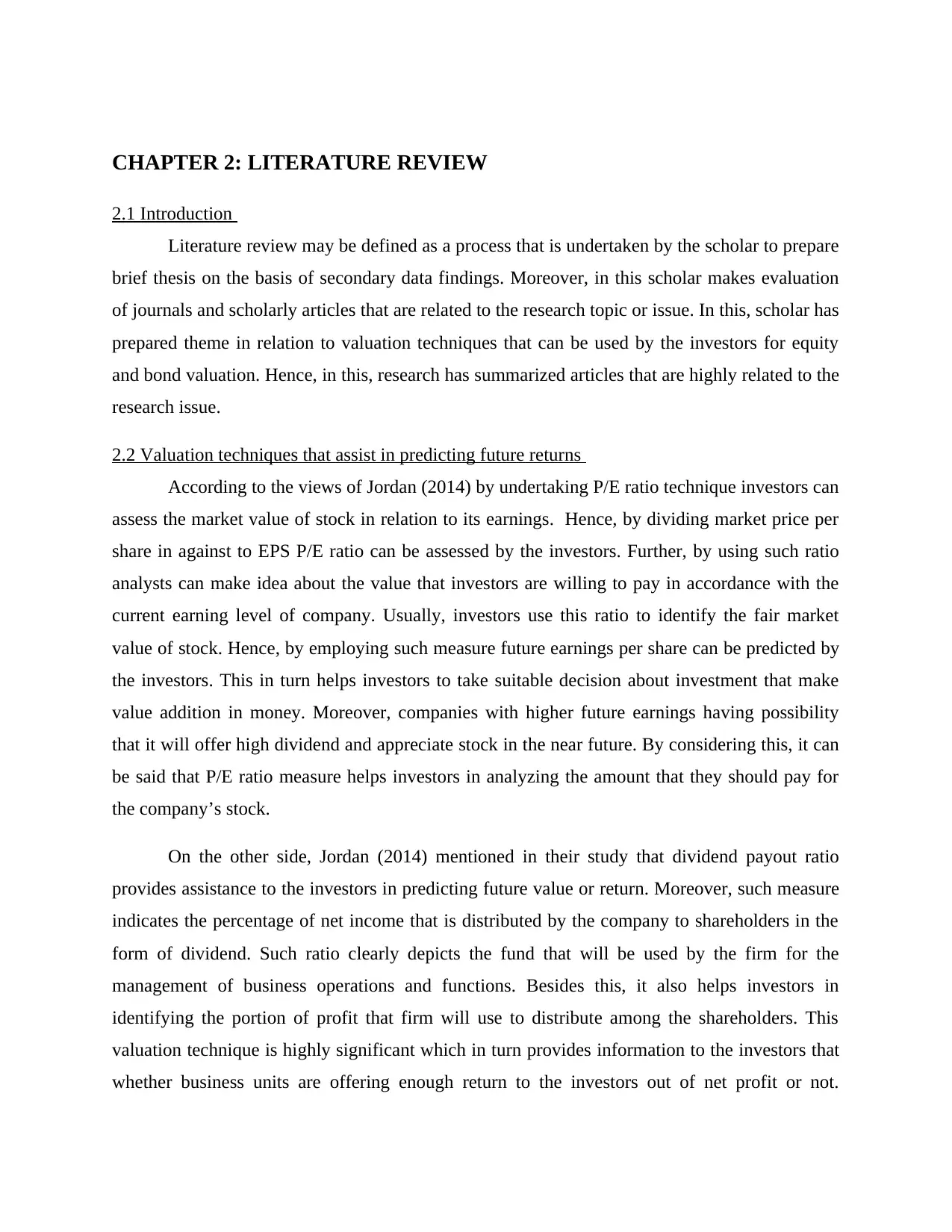
CHAPTER 2: LITERATURE REVIEW
2.1 Introduction
Literature review may be defined as a process that is undertaken by the scholar to prepare
brief thesis on the basis of secondary data findings. Moreover, in this scholar makes evaluation
of journals and scholarly articles that are related to the research topic or issue. In this, scholar has
prepared theme in relation to valuation techniques that can be used by the investors for equity
and bond valuation. Hence, in this, research has summarized articles that are highly related to the
research issue.
2.2 Valuation techniques that assist in predicting future returns
According to the views of Jordan (2014) by undertaking P/E ratio technique investors can
assess the market value of stock in relation to its earnings. Hence, by dividing market price per
share in against to EPS P/E ratio can be assessed by the investors. Further, by using such ratio
analysts can make idea about the value that investors are willing to pay in accordance with the
current earning level of company. Usually, investors use this ratio to identify the fair market
value of stock. Hence, by employing such measure future earnings per share can be predicted by
the investors. This in turn helps investors to take suitable decision about investment that make
value addition in money. Moreover, companies with higher future earnings having possibility
that it will offer high dividend and appreciate stock in the near future. By considering this, it can
be said that P/E ratio measure helps investors in analyzing the amount that they should pay for
the company’s stock.
On the other side, Jordan (2014) mentioned in their study that dividend payout ratio
provides assistance to the investors in predicting future value or return. Moreover, such measure
indicates the percentage of net income that is distributed by the company to shareholders in the
form of dividend. Such ratio clearly depicts the fund that will be used by the firm for the
management of business operations and functions. Besides this, it also helps investors in
identifying the portion of profit that firm will use to distribute among the shareholders. This
valuation technique is highly significant which in turn provides information to the investors that
whether business units are offering enough return to the investors out of net profit or not.
2.1 Introduction
Literature review may be defined as a process that is undertaken by the scholar to prepare
brief thesis on the basis of secondary data findings. Moreover, in this scholar makes evaluation
of journals and scholarly articles that are related to the research topic or issue. In this, scholar has
prepared theme in relation to valuation techniques that can be used by the investors for equity
and bond valuation. Hence, in this, research has summarized articles that are highly related to the
research issue.
2.2 Valuation techniques that assist in predicting future returns
According to the views of Jordan (2014) by undertaking P/E ratio technique investors can
assess the market value of stock in relation to its earnings. Hence, by dividing market price per
share in against to EPS P/E ratio can be assessed by the investors. Further, by using such ratio
analysts can make idea about the value that investors are willing to pay in accordance with the
current earning level of company. Usually, investors use this ratio to identify the fair market
value of stock. Hence, by employing such measure future earnings per share can be predicted by
the investors. This in turn helps investors to take suitable decision about investment that make
value addition in money. Moreover, companies with higher future earnings having possibility
that it will offer high dividend and appreciate stock in the near future. By considering this, it can
be said that P/E ratio measure helps investors in analyzing the amount that they should pay for
the company’s stock.
On the other side, Jordan (2014) mentioned in their study that dividend payout ratio
provides assistance to the investors in predicting future value or return. Moreover, such measure
indicates the percentage of net income that is distributed by the company to shareholders in the
form of dividend. Such ratio clearly depicts the fund that will be used by the firm for the
management of business operations and functions. Besides this, it also helps investors in
identifying the portion of profit that firm will use to distribute among the shareholders. This
valuation technique is highly significant which in turn provides information to the investors that
whether business units are offering enough return to the investors out of net profit or not.
Paraphrase This Document
Need a fresh take? Get an instant paraphrase of this document with our AI Paraphraser
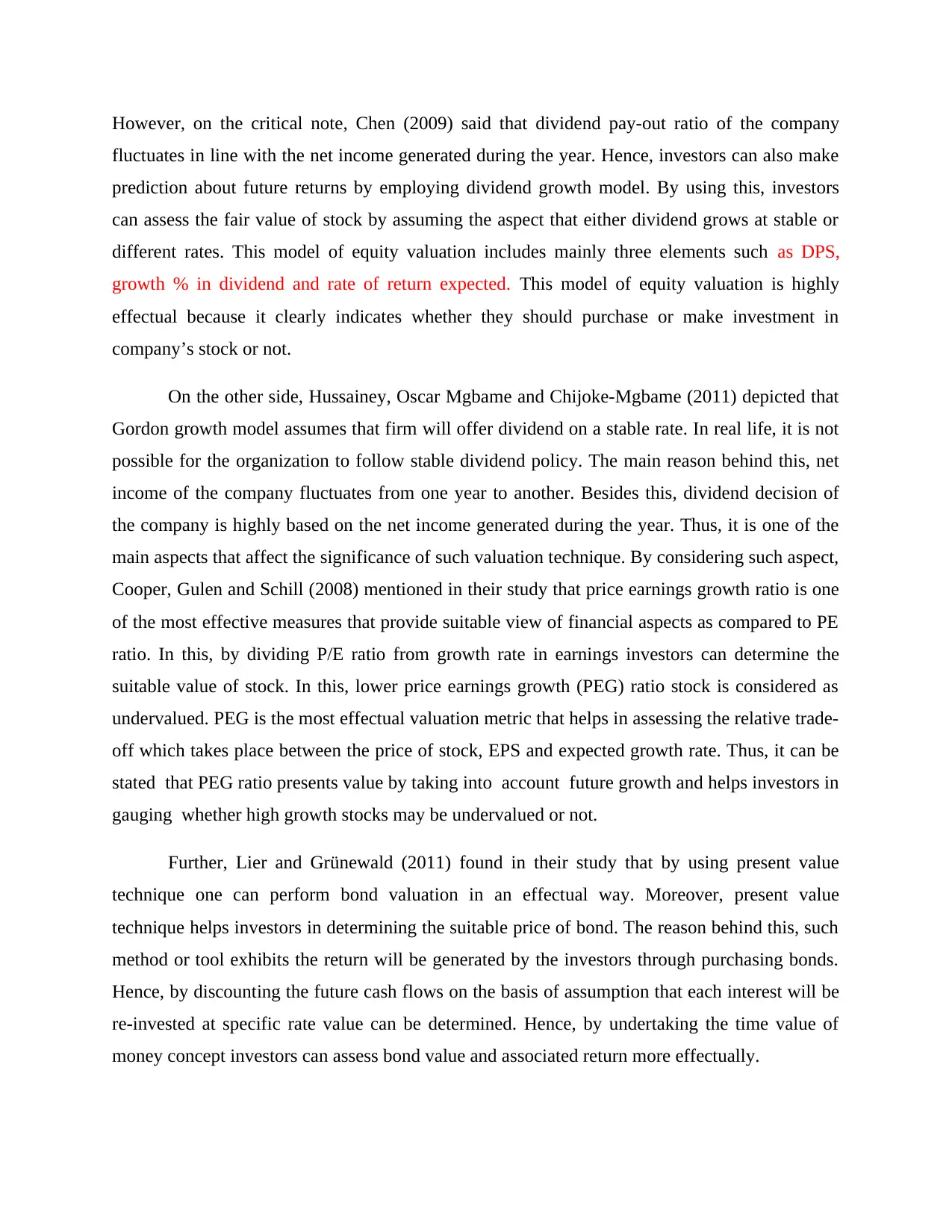
However, on the critical note, Chen (2009) said that dividend pay-out ratio of the company
fluctuates in line with the net income generated during the year. Hence, investors can also make
prediction about future returns by employing dividend growth model. By using this, investors
can assess the fair value of stock by assuming the aspect that either dividend grows at stable or
different rates. This model of equity valuation includes mainly three elements such as DPS,
growth % in dividend and rate of return expected. This model of equity valuation is highly
effectual because it clearly indicates whether they should purchase or make investment in
company’s stock or not.
On the other side, Hussainey, Oscar Mgbame and Chijoke-Mgbame (2011) depicted that
Gordon growth model assumes that firm will offer dividend on a stable rate. In real life, it is not
possible for the organization to follow stable dividend policy. The main reason behind this, net
income of the company fluctuates from one year to another. Besides this, dividend decision of
the company is highly based on the net income generated during the year. Thus, it is one of the
main aspects that affect the significance of such valuation technique. By considering such aspect,
Cooper, Gulen and Schill (2008) mentioned in their study that price earnings growth ratio is one
of the most effective measures that provide suitable view of financial aspects as compared to PE
ratio. In this, by dividing P/E ratio from growth rate in earnings investors can determine the
suitable value of stock. In this, lower price earnings growth (PEG) ratio stock is considered as
undervalued. PEG is the most effectual valuation metric that helps in assessing the relative trade-
off which takes place between the price of stock, EPS and expected growth rate. Thus, it can be
stated that PEG ratio presents value by taking into account future growth and helps investors in
gauging whether high growth stocks may be undervalued or not.
Further, Lier and Grünewald (2011) found in their study that by using present value
technique one can perform bond valuation in an effectual way. Moreover, present value
technique helps investors in determining the suitable price of bond. The reason behind this, such
method or tool exhibits the return will be generated by the investors through purchasing bonds.
Hence, by discounting the future cash flows on the basis of assumption that each interest will be
re-invested at specific rate value can be determined. Hence, by undertaking the time value of
money concept investors can assess bond value and associated return more effectually.
fluctuates in line with the net income generated during the year. Hence, investors can also make
prediction about future returns by employing dividend growth model. By using this, investors
can assess the fair value of stock by assuming the aspect that either dividend grows at stable or
different rates. This model of equity valuation includes mainly three elements such as DPS,
growth % in dividend and rate of return expected. This model of equity valuation is highly
effectual because it clearly indicates whether they should purchase or make investment in
company’s stock or not.
On the other side, Hussainey, Oscar Mgbame and Chijoke-Mgbame (2011) depicted that
Gordon growth model assumes that firm will offer dividend on a stable rate. In real life, it is not
possible for the organization to follow stable dividend policy. The main reason behind this, net
income of the company fluctuates from one year to another. Besides this, dividend decision of
the company is highly based on the net income generated during the year. Thus, it is one of the
main aspects that affect the significance of such valuation technique. By considering such aspect,
Cooper, Gulen and Schill (2008) mentioned in their study that price earnings growth ratio is one
of the most effective measures that provide suitable view of financial aspects as compared to PE
ratio. In this, by dividing P/E ratio from growth rate in earnings investors can determine the
suitable value of stock. In this, lower price earnings growth (PEG) ratio stock is considered as
undervalued. PEG is the most effectual valuation metric that helps in assessing the relative trade-
off which takes place between the price of stock, EPS and expected growth rate. Thus, it can be
stated that PEG ratio presents value by taking into account future growth and helps investors in
gauging whether high growth stocks may be undervalued or not.
Further, Lier and Grünewald (2011) found in their study that by using present value
technique one can perform bond valuation in an effectual way. Moreover, present value
technique helps investors in determining the suitable price of bond. The reason behind this, such
method or tool exhibits the return will be generated by the investors through purchasing bonds.
Hence, by discounting the future cash flows on the basis of assumption that each interest will be
re-invested at specific rate value can be determined. Hence, by undertaking the time value of
money concept investors can assess bond value and associated return more effectually.
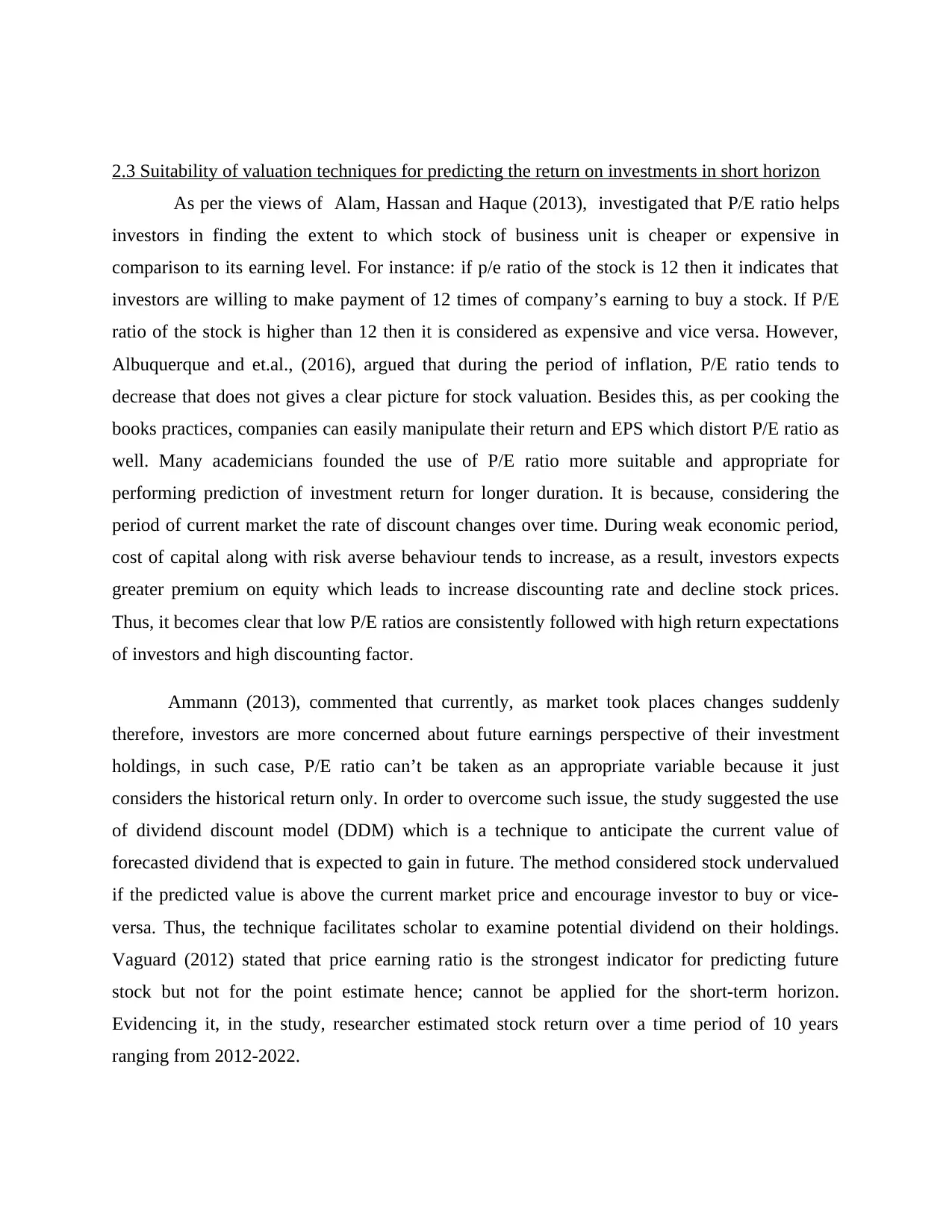
2.3 Suitability of valuation techniques for predicting the return on investments in short horizon
As per the views of Alam, Hassan and Haque (2013), investigated that P/E ratio helps
investors in finding the extent to which stock of business unit is cheaper or expensive in
comparison to its earning level. For instance: if p/e ratio of the stock is 12 then it indicates that
investors are willing to make payment of 12 times of company’s earning to buy a stock. If P/E
ratio of the stock is higher than 12 then it is considered as expensive and vice versa. However,
Albuquerque and et.al., (2016), argued that during the period of inflation, P/E ratio tends to
decrease that does not gives a clear picture for stock valuation. Besides this, as per cooking the
books practices, companies can easily manipulate their return and EPS which distort P/E ratio as
well. Many academicians founded the use of P/E ratio more suitable and appropriate for
performing prediction of investment return for longer duration. It is because, considering the
period of current market the rate of discount changes over time. During weak economic period,
cost of capital along with risk averse behaviour tends to increase, as a result, investors expects
greater premium on equity which leads to increase discounting rate and decline stock prices.
Thus, it becomes clear that low P/E ratios are consistently followed with high return expectations
of investors and high discounting factor.
Ammann (2013), commented that currently, as market took places changes suddenly
therefore, investors are more concerned about future earnings perspective of their investment
holdings, in such case, P/E ratio can’t be taken as an appropriate variable because it just
considers the historical return only. In order to overcome such issue, the study suggested the use
of dividend discount model (DDM) which is a technique to anticipate the current value of
forecasted dividend that is expected to gain in future. The method considered stock undervalued
if the predicted value is above the current market price and encourage investor to buy or vice-
versa. Thus, the technique facilitates scholar to examine potential dividend on their holdings.
Vaguard (2012) stated that price earning ratio is the strongest indicator for predicting future
stock but not for the point estimate hence; cannot be applied for the short-term horizon.
Evidencing it, in the study, researcher estimated stock return over a time period of 10 years
ranging from 2012-2022.
As per the views of Alam, Hassan and Haque (2013), investigated that P/E ratio helps
investors in finding the extent to which stock of business unit is cheaper or expensive in
comparison to its earning level. For instance: if p/e ratio of the stock is 12 then it indicates that
investors are willing to make payment of 12 times of company’s earning to buy a stock. If P/E
ratio of the stock is higher than 12 then it is considered as expensive and vice versa. However,
Albuquerque and et.al., (2016), argued that during the period of inflation, P/E ratio tends to
decrease that does not gives a clear picture for stock valuation. Besides this, as per cooking the
books practices, companies can easily manipulate their return and EPS which distort P/E ratio as
well. Many academicians founded the use of P/E ratio more suitable and appropriate for
performing prediction of investment return for longer duration. It is because, considering the
period of current market the rate of discount changes over time. During weak economic period,
cost of capital along with risk averse behaviour tends to increase, as a result, investors expects
greater premium on equity which leads to increase discounting rate and decline stock prices.
Thus, it becomes clear that low P/E ratios are consistently followed with high return expectations
of investors and high discounting factor.
Ammann (2013), commented that currently, as market took places changes suddenly
therefore, investors are more concerned about future earnings perspective of their investment
holdings, in such case, P/E ratio can’t be taken as an appropriate variable because it just
considers the historical return only. In order to overcome such issue, the study suggested the use
of dividend discount model (DDM) which is a technique to anticipate the current value of
forecasted dividend that is expected to gain in future. The method considered stock undervalued
if the predicted value is above the current market price and encourage investor to buy or vice-
versa. Thus, the technique facilitates scholar to examine potential dividend on their holdings.
Vaguard (2012) stated that price earning ratio is the strongest indicator for predicting future
stock but not for the point estimate hence; cannot be applied for the short-term horizon.
Evidencing it, in the study, researcher estimated stock return over a time period of 10 years
ranging from 2012-2022.
⊘ This is a preview!⊘
Do you want full access?
Subscribe today to unlock all pages.

Trusted by 1+ million students worldwide
1 out of 35
Your All-in-One AI-Powered Toolkit for Academic Success.
+13062052269
info@desklib.com
Available 24*7 on WhatsApp / Email
![[object Object]](/_next/static/media/star-bottom.7253800d.svg)
Unlock your academic potential
Copyright © 2020–2025 A2Z Services. All Rights Reserved. Developed and managed by ZUCOL.


